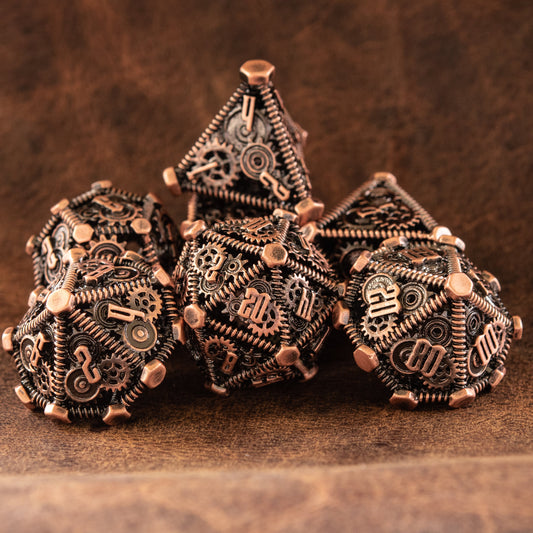How DND Dice Work: Understanding DND Dice Mechanics, Types, and Usage in Tabletop Gameplay
Share
Dungeons & Dragons (DND) is a tabletop role-playing game that has captivated the imaginations of players for decades. One of the most iconic and essential elements of DND is its unique set of dice, which play a crucial role in determining the outcomes of various actions within the game. In this blog, we will explore how DND dice work by understanding DND dice mechanics, the different types of DND dice, and how to use them effectively in gameplay, all within the context of DND's rules and playstyle.
Understanding DND Dice Mechanics
At the heart of DND gameplay lies the roll of the dice. The mechanics of DND dice are designed to introduce an element of chance, making each game session unpredictable and exciting. Here's a breakdown of how these mechanics work within the rules of the game:
-
Dice Notation: In DND, dice rolls are often represented by a notation such as "d20" or "3d6". The "d" stands for "die" or "dice", followed by a number indicating the type of die. For example, "d20" refers to a 20-sided die, while "3d6" means rolling three 6-sided dice. This notation is used extensively in the game's rules for various checks and outcomes.
-
Rolling for Outcomes: Players roll dice to determine the success or failure of their actions. The Dungeon Master (DM) sets a Difficulty Class (DC) for various tasks (e.g., climbing a wall, persuading a guard). Players roll the appropriate die and add any relevant modifiers (such as skill bonuses). If the total meets or exceeds the DC, the action succeeds. This mechanic is central to the game's rules and is used for combat, skill checks, and saving throws.
-
Critical Rolls: Rolling a natural 20 on a d20 (without any modifiers) is considered a critical success, often leading to extraordinary outcomes, such as double damage in combat. Conversely, rolling a natural 1 is a critical failure, resulting in particularly unfavorable results. These critical rolls add excitement and drama to the game.
Types of DND Dice
DND uses a variety of polyhedral dice, each serving a specific purpose in the game. Here are the main types of dice you'll encounter and their typical uses as per the game's rules:
-
d20 (20-sided die): The most iconic die in DND, used primarily for attack rolls, saving throws, and skill checks. It's the die that drives most of the game's action and outcomes.
-
d12 (12-sided die): Often used for determining damage from powerful weapons or spells. It's less common but crucial for certain character classes and abilities.
-
d10 (10-sided die): Commonly used for damage rolls and certain percentile rolls (when combined with another d10). It's also used for some spell effects.
-
d8 (8-sided die): Used for damage rolls, particularly for medium-strength weapons and spells. It's a versatile die used by many character classes.
-
d6 (6-sided die): The standard die for many damage rolls and some character abilities. It's also used in character creation for determining ability scores.
-
d4 (4-sided die): Used for smaller damage rolls and certain spell effects. It's less common but still important for specific situations.
-
Percentile Dice (d100): Represented by two d10s, one indicating the tens place and the other the units place, used for determining percentages. This is often used for random tables and certain magical effects.
Using DND Dice in Gameplay
Knowing how to use DND dice effectively within the game's rules can greatly enhance your gameplay experience. Here are some tips for using DND dice in your game:
-
Familiarize Yourself with Dice Notation: Understanding the various dice notations and their meanings is crucial. Practice rolling different combinations to get comfortable with the mechanics.
-
Keep Your Dice Organized: Having a dedicated dice set and keeping them organized can save time during gameplay. Consider using a dice tray to prevent dice from rolling off the table.
-
Communicate with Your DM: Always communicate with your DM about the rolls you are making and the modifiers you are adding. This ensures transparency and fairness in the game.
-
Practice Rolling Techniques: While the outcome of a dice roll is ultimately random, practicing a consistent rolling technique can help ensure fair rolls. Avoid "flicking" or "dropping" dice in a way that might influence the outcome.
-
Enjoy the Element of Chance: Embrace the unpredictability that dice rolls bring to the game. Whether you roll a critical success or a critical failure, it's all part of the DND experience.
Conclusion
Understanding how DND dice work is essential for any player looking to fully immerse themselves in the game. By grasping the mechanics of DND dice, familiarizing yourself with the different types of dice, and learning how to use them effectively in gameplay, you can enhance your DND experience and enjoy the thrilling unpredictability that these polyhedral dice bring to the table. So grab your dice, gather your party, and embark on an adventure filled with excitement and chance!


